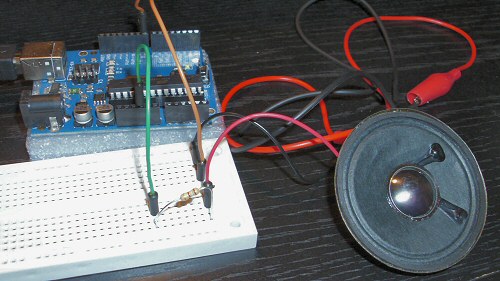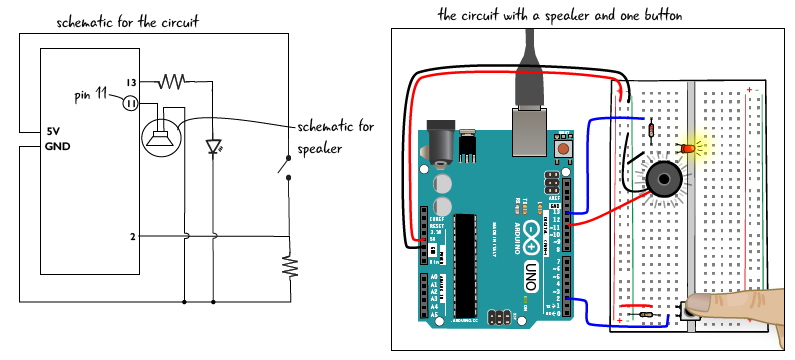

- #ARDUINO SPEAKER CODE HOW TO#
- #ARDUINO SPEAKER CODE CODE#
- #ARDUINO SPEAKER CODE SERIES#
- #ARDUINO SPEAKER CODE DOWNLOAD#
#ARDUINO SPEAKER CODE DOWNLOAD#
To hear a 16kHz encoding, you'll need to download the mellis PCM file from the high-low tech blog post. This is because it still thinks you're using an 8kHz file. wav without changing the code, you'll hear a slowed down version of the file. I will warn you however that it takes twice as much memory, meaning you can hold maybe 2 seconds of audio now instead of 5? It's significant compared to what it originally was, which was not much. This allows higher frequencies to be represented better (something something Nyquist), and also allows voice files to sound better. You can also downsample your wav to a less extreme 16kHz audio file. Increasing the playback frequency to 16kHz I think I'm just reinventing the wheel here, but this slight modification made my sound files a little more clear.

So something like (diff from 128 is ) becomes after a 5x contrast increase. I iterated through in Python and found the largest offset from 128, then multiplied all samples' differences with 128 by some large constant and added them back. I'm encoding voice files specifically, so I figured I could increase the contrast in the file to get better volume.

Paste it in the example code, comment out or delete the old line with all the values, and hit start! Your Arduino should play your sound file! Additional things you can try Optimizing for voice I would like this better if it were all on one line, but that might be a personal preference. Turns out lots of people have solved this problem, it's just very difficult to find a web version that will do it for you in JS.Īnyway, it gives you a nice long text of values you can copy and paste into your code. Instead, I found this web version of wav2c. I tried to modify it in Processing to compile, but for some reason it wouldn't parse the. wav to my clipboard, but could't run it because it was outdated. I then tried to use their Processing script to copy a. wav using this site, which is handy because it has many of the downsampling options I wanted. I used QuickTime to record some brief audio, and then converted the. wav will want to copy as char codes instead of actual byte values. wav, you'll need to get the byte values onto your clipboard somehow to paste into the PROGMEM sample array from the example, which is nontrivial because the. You can do this conversion online, or maybe you already have a local program that can do this. What you need to do is record some audio, then convert it into a. They recommend that you use an 8-bit, 8000Hz (8kHz) sample rate, mono channel WAV file. Their example shows a long array of byte values, centered on 128 as their zero point. I'm glad you asked! This was the fun part. When it starts, you should hear a lady's voice say "Arduino Demilvinove" or however you spell it.
#ARDUINO SPEAKER CODE CODE#
With the resistor, this is limited to 5V/338 ≈ 15 mA.įor the software, the starter code from high-low tech should boot directly and work.

I think their max safe draw is 20mA, and this speaker is probably 8Ω and would draw 5V/8Ω = 625mA at max output.
#ARDUINO SPEAKER CODE SERIES#
I also added a 330Ω resistor in series with the speaker to limit the current draw from the Arduino's pins. I actually think the speaker is voltage polarity agnostic, so either direction should work. Hardware-wise you need to connect the GND to GND, and pin 11 of your Arduino to the V+ of the speaker. You can also find this library from Arduino's IDE directly by searching PCM Audio in the Tools->Manage Libraries. Primarily, this relies on some Arduino Playground code written by Michael Smith, and the lovely tutorial by High-Low Tech Group at MIT Media Lab. Luckily many people have thought of this, and have written lovely libraries for it. It makes sense for a microcontroller to play WAVs - they're already just pressure levels, so you should be able to play each pressure level as a tone with a set time. The results are useable - loud enough to be heard in a bedroom and passable for voices. I will probably end up using a transistor, but at the moment I just wanted to test the feasability of playing audio without anything except the speaker and Arduino. I don't have any audio amplifiers lying around, and besides, there's not a ton of room in the button itself to fit that. As an intermediate step, I wanted to play custom sounds from the speaker. I'm currently doing an Easy button hack-apart, which I'll showcase later.
#ARDUINO SPEAKER CODE HOW TO#
Today in Being Lazy With Andy, I'm gonna show you how to play audio directly from a microcontroller's output pins - no op amp, no transistor. Playing sounds with an Arduino, speaker, and no amplifier


 0 kommentar(er)
0 kommentar(er)
